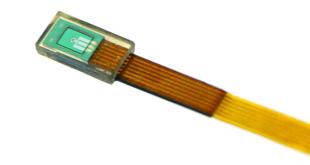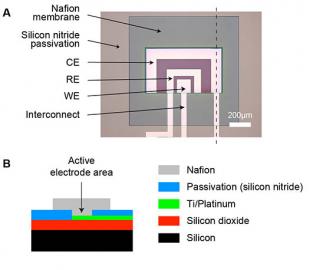IMPACT (2013-2019, £5.2M, EPSRC Programme Grant Project, Implanted Microsystems for Personal Anti-Cancer Treatment) was funded by The IMPACT Project team consisted of engineers, chemists, veterinary clinicians, social scientists and human cancer specialists from the University of Edinburgh, Heriot-Watt University and the Western General Hospital. This multi-disciplinary group was led by Prof Alan Murray from the University of Edinburgh's School of Engineering.
Project IMPACT Introductory Video
You can view this video on Media Hopper or on YouTube.
Silicon technology can now be integrated with sensors of temperature, pH, oxygen concentration and of biological molecules. This allows chips to be developed that can monitor the body from the inside and in great detail.
IMPACT showed:
IMPLANTED SENSORS CAN MEASURE THE STATUS OF A TUMOUR.

That miniaturised Oxygen sensors can make clinically-useful measurements of pH and oxygen saturation in vitro and in small (rat) and large (sheep) animal models.
KEY PAPER - Real-time measurement of tumour hypoxia using an implantable microfabricated oxygen sensor, 2020, J.R.K. Marland, M.E. Gray, C. Dunare, E.O. Blair, A. Tsiamis, P. Sullivan, E. González-Fernández S.N. Greenhalgh, R. Gregson, R.E. Clutton, M.M. Parys, A. Dyson, M. Singer, I.H. Kunkler, M.A. Potter, S. Mitra, J.G. Terry, S. Smith, A.R. Mount, I. Underwood, A.J. Walton, D.J. Argyle, A.F. Murray
ENGRXIV
SENSORS CAN ALSO BE USED TO MONITOR HEALING IN INTERNAL, POST-OPERATIVE WOUNDS
Demonstrated in small (rat) and large (pig) animal models.
KEY PAPER - In vivo validation of a miniaturized electrochemical oxygen sensor for measuring intestinal oxygen tension, 2019, J. Marland , C. Dunare , E. Blair , J. Meehan , C. Ward , S. Langdon , A. Tsiamis , I. Kunkler , A.F. Murray, D. Argyle , A. Dyson , M. Singer , M. Potter
AMERICAN JOURNAL OF PHYSIOLOGY
ELECTROCHEMICAL SENSORS CAN BE MINIATURISED
Electrochemical peptide-based sensors can be miniaturised and implanted to measure specific biomarkers, including Caspases, Trypsine and Human Neutrophil Elastase
KEY PAPER - Electrochemical sensing of human neutrophil elastase and polymorphonuclear neutrophil active, 2018, E. González-Fernández, M. Staderinia, A. Yussof, E. Scholefield, A. F. Murray, A. R. Mount, M. Bradley.
BIOSENSORS AND BIOELECTRONICS
AN INERT “PRO DRUG” CAN BE ACTIVATED ELECTRONICALLY TO BECOME "LOCAL CHEMOTHERAPY"
It is possible to develop an inert “pro drug” that, when injected systemically, can be activated ELECTRONICALLY by and implant chip at the site of the tumour to produce a cytotoxic drug such as Oxalyplatin (used for colorectal cancer) and Cisplatin (used for a wide range of solid cancers). This will reduce or remove the side-effects of conventional chemotherapy.
KEY PAPER - Electrodrugs: an electrochemical prodrug activation strategy, 2018D. Norman, A. F. Murray, M. Bradley.
ROYAL SOCIETY CHEMISTRY COMMUNICATIONS
A LUNG TUMOUR ENDEMIC IN SHEEP IS AN EXCELLENT MODEL OF HUMAN CANCER
A lung tumour endemic in many flocks of sheep (Ovine Pulmonary Adenocarcinoma) is an excellent model for studying multiple aspects of human lung cancer biology. As a result, in vivo and in vitro experimental models have been developed to determine the molecular pathways involved in lung cancer pathogenesis.
KEY PAPER - Ovine Pulmonary Adenocarcinoma: A Unique Model to Improve Lung Cancer Research, 2019, M. E. Gray, J. Meehan, P. Sullivan, J. R. K. Marland, S. N. Greenhalgh, R. Gregson, R. E. Clutton, C. Ward, C. Cousens D. Griffiths, A. Murray, and D. Argyle.
FRONTIERS IN ONCOLOGY
MANY COMMON MATERIALS IN SILICON FABRICATION ARE BIOCOMPATIBLE

That SiO2, Si3N4, Parylene‐C, Nafion, OG116‐31 resin, and Pt are suitable materials for implantable medical devices placed within a solid tumour. Our results suggest that the materials caused no deleterious effects on the tumour and do not trigger a significant foreign body response. This is the first time that the reaction of cancer tissue (as opposed to healthy tissue) has been test in this way.
KEY PAPER - Biocompatibility of Common Implantable Sensor Materials in a Tumour Xenograft Model, 2018, M. E. Gray , J. Meehan , E. O. Blair , C. Ward , Simon P. Langdon , L. R. Morrison, J. R. K. Marland , A. Tsiamis , I. H. Kunkler , A. Murray , D. Argyle.
JOURNAL OF BIOMEDICAL MATERIALS RESEARCH PART B: APPLIED BIOMATERIALS
CANCER PATIENTS ARE ACCEPTING OF IMPLANT TECHNOLOGY
Patients feel that none of the IMPACT technology's potential downsides would preclude their further development for radiotherapy treatment of breast cancer. This encourages further research and development towards early clinical testing of biosensors for breast cancer and other solid tumours.
KEY PAPER - Horizon scanning implanted biosensors in personalising breast cancer. management: First pilot study of breast cancer patients views, 2018, T. Ikegwuono, G.H. Haddow, J. Tait, I. Kunkler and A.F. Murray,
HEALTH SCIENCE REPORTS
CANCER CELLS CAN BE PATTERNED ON SILICON SENSOR CHIPS
Biological cells can be caused to grow in pre-defined patterns on a silicon (sensor) chip using normal photolithographic materials and materials.
KEY PAPER - Engineering neuronal networks on photolithographically defined, biologically activated silicon substrates, M. Hughes, A. Bunting, P. Brennan, A.F. Murray, M. Shipston, 2014.
THE LANCET




